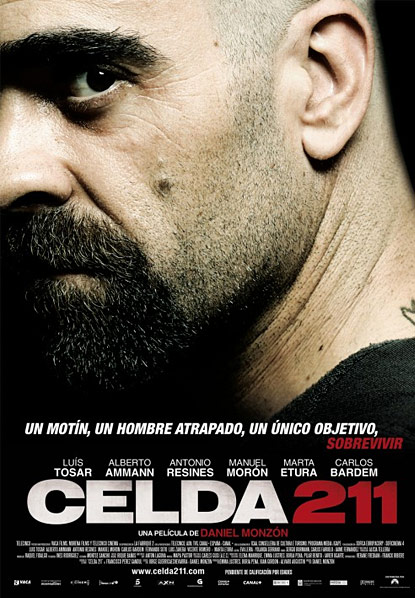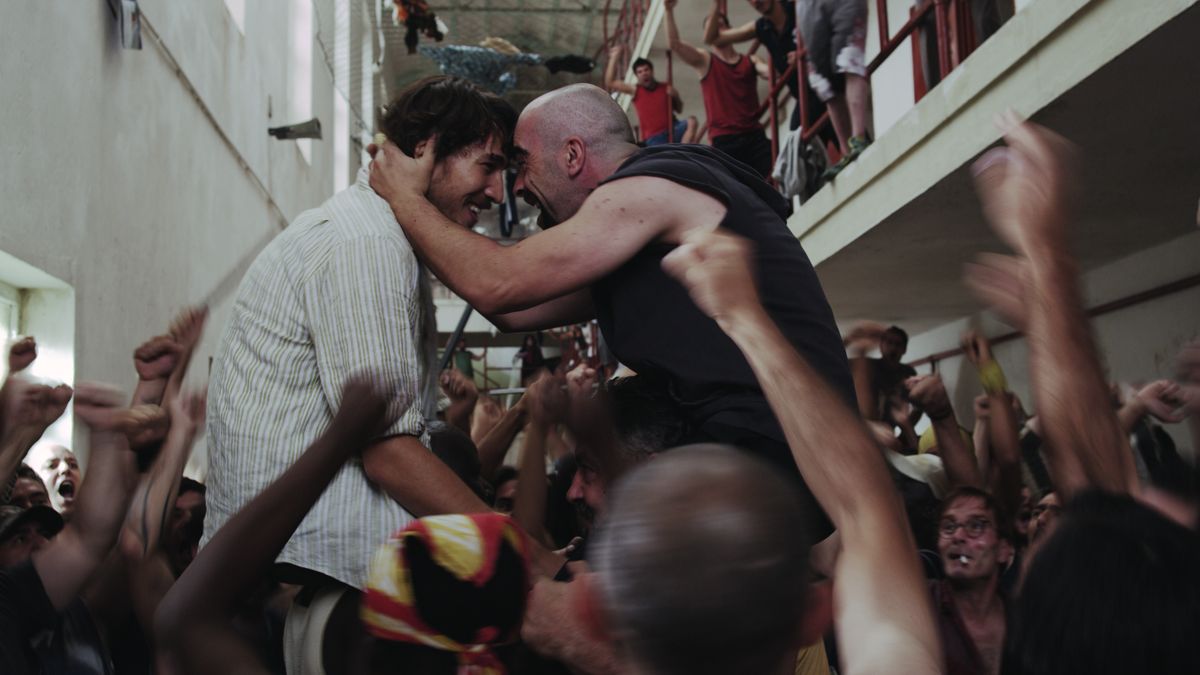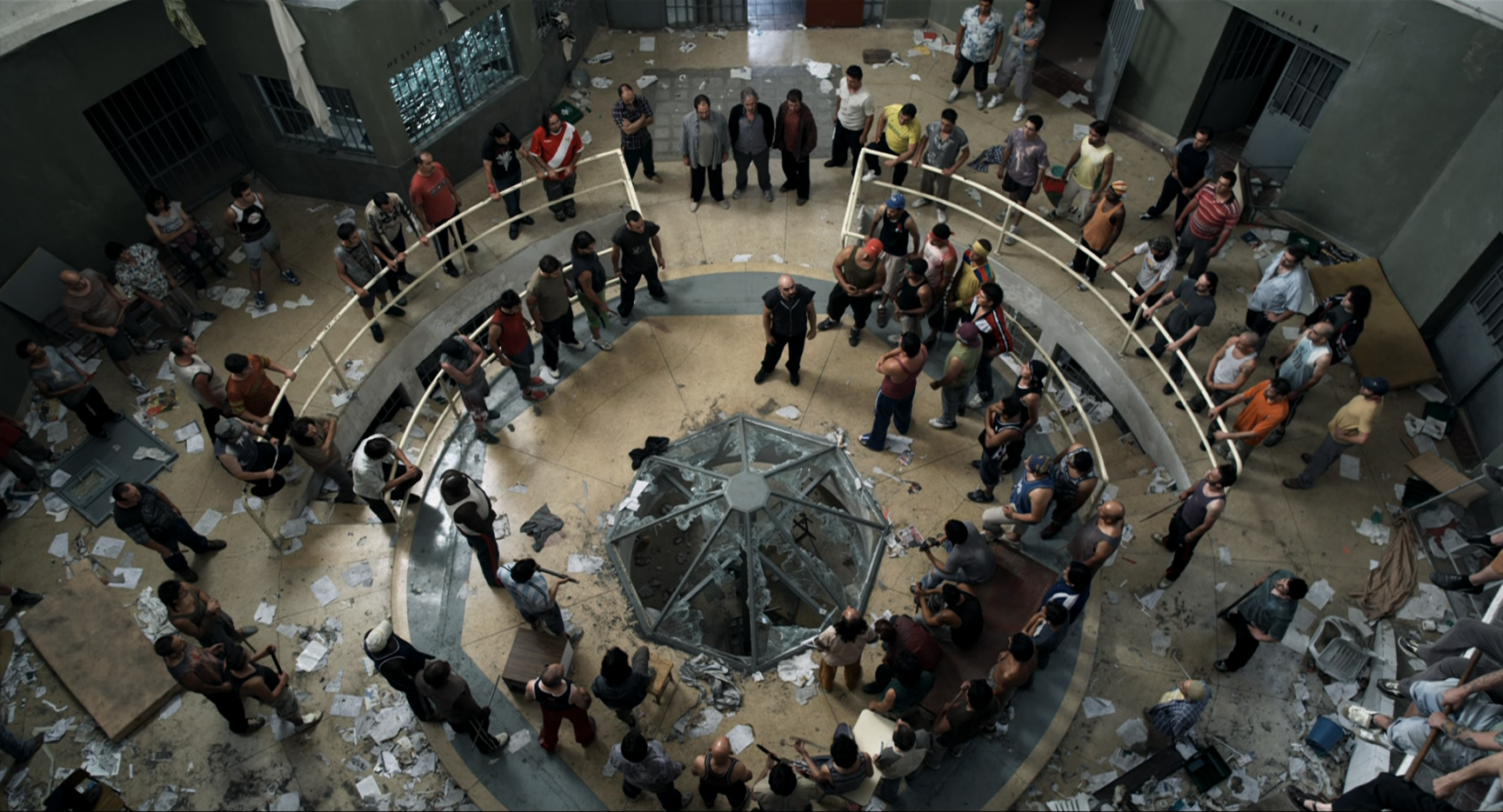
Directed by: Daniel Monzón || Produced by: Emma Lustres, Borja Pena, Juan Gordon, Álvaro Augustin
Screenplay by: Jorge Guerricaechevarría, Daniel Monzón || Starring: Luis Tosar, Alberto Ammann, Antonio Resines, Manuel Morón, Carlos Bardem, Luis Zahera, Vicente Romero, Fernando Soto, Marta Etura
Music by: Roque Baños || Cinematography: Carles Gusi || Edited by: Mapa Pastor || Country: Spain, France || Language: Spanish
Running Time: 113 minutes
Until I stopped and thought about it, I didn’t realize how familiar I was with the prison film subgenre. Foreign-language dramas like A Prophet (2009) by Jacques Audiard or Hollywood classics like Cool Hand Luke (1967), The Shawshank Redemption (1994), The Green Mile (1999), or even bizarre genre films like Alien 3 (1992) and The Platform (2019) all take place almost exclusively within the confines of a penitentiary and make the dynamics of prison life a central theme of their narratives. Even the postmodern, Kafkaesque maze that is Cube (1997), a science-fiction favorite of mine, is inspired by real-life correctional facilities and names its main characters after real-life prisons.

Luis Tosar (right) congratulates — but also warns — Alberto Ammann (left) for thinking of a clever riot tactic that circumvented a tactical police raid into the occupied prison without the former’s permission.
Cell 211, a notable Spanish prison drama from veteran filmmaker Daniel Monzón, released the same year as the celebrated Prophet but found much less mainstream traction overseas despite having a far more traditional narrative structure, as well as a premise to die for: A rookie prison guard (Alberto Ammann) tours his future workplace the day before he starts work only to be caught in the middle of a prison riot; in order to survive, he pretends to be a new prisoner and becomes a de facto undercover agent as the rioters, led by an intimidating Luis Tosar, take political hostages, violently subdue dissenters, and demand systemic changes to their penitentiary, alleging serious misconduct by the correctional staff. Much like A Prophet, Cell 211 doesn’t end nearly as strongly as it opens, but Ammann’s protagonist’s arc is memorable, while every act had me guessing where the plot would go (i.e. narrative predictability isn’t a problem here). Combine all the above with reliable documentarian-esque camerawork and Cell 211 ironically makes a far more effective “revolutionary narrative” than most cinema about national independence movements.
With regards to its direction, co-writer-director Monzón employs the cinemá vérité style of handheld cinematography that gives modern low to moderately budgeted thrillers that scrappy, gritty feeling of the viewer participating in the fast-paced action on display. Director of photography Carles Gusi at times abandons conventional dramatic techniques like shot-reverse-shot setups in favor of quick camera pans between multiple characters in a conversation, an approach that certain low-budget (e.g. Harbinger Down [2015]) and big-budget (e.g. The Revenant [2015]) Hollywood movies have abused out of either convenience or auteur self-indulgence. That being said, Cell 211 uses a mix of clever framing and shallow focus to conceal the identity of Tosar’s lead character throughout the first act, most of the footage outside of the prison cells is dominated by slower, more static cinematography, and the morbid prologue about the previous tenant of the titular cell is lit and shot almost like an arthouse student short film. The visual composition of Cell 211 is quite diverse, in other words, but its dominant aesthetic is without question the pseudo-documentarian camerawork that emphasizes narrative tension over mise-en-scène.
With regards to characters, the heart of the movie lies in the fractious relationship between Ammann and Tosar, with the former’s loyalty to the latter shifting over the course of the story in a believable way. Tosar sounds like he smoked a couple hundred cigarettes and looks like he lifted weights like crazy for his maximum security convict role, and juxtaposes well against Ammann’s slim, boyish looks. All their scenes together are so memorable that much of the drama without both of them on screen pales in comparison, however.
By the same token, Cell 211 falls apart a bit by the third act once Ammann’s motivation for keeping his true identity secret falls by the wayside thanks to an overinvolvement of a love interest (Marta Etura), including but not limited to multiple superfluous flashbacks. Additional contributing script factors that hobble the movie’s conclusion involve weird, dimly lit — like, almost in complete shadow, mind you — flashforward sequences where minor characters recount the riot’s events to a panel of enigmatic government officials, as well as a betrayal by a certain major character that reads more as anticlimactic than tragic.

Creative camera angles and a variety of cinematographic approaches help Cell 211 get the most out of its few shooting locations.
If you accept its mediocre ending as a bitter pill to swallow, that’s primarily a function of how effective the first two acts of Cell 211 are by comparison. The film’s direction commands so much effective characterization, editing, and fluid plot progression that I struggle to criticize the film too much for how it ends. In that sense, Cell 211 is quite comparable to A Prophet save for how much more actively its characters drive the story from one sequence to the next, whereas Jacques Audiard’s picture — while still impressive — feels like a series of diary entries without much narrative connective tissue between them. Cell 211’s combination of tried and true cinemá vérité aesthetics within a tight, well paced screenplay therefore maintain tension throughout its story without resorting to screenwriting contrivances or exploitative violence. The movie isn’t perfect, but it may be the perfect “prison movie.”
———————————————————————————————————————————————————————————
SUMMARY & RECOMMENDATION: Though not without its screenplay missteps, Cell 211 ultimately summarizes what makes prison dramas relatable and even timeless across multicultural audiences: They’re effective “bottle episodes” that rely on familiar character archetypes to reenact microcosms of society, just with somewhat blunter, more violent personalities. With diverse cinematography, a couple of great starring actors, and a handful of modest yet well utilized locations, Cell 211 covers a great deal more narrative territory than many longer, supposedly more epic films.
— However… the film’s ending, while not illogical or cheap, somewhat circumvents the brilliant tension built by Luis Tosar and Alberto Ammann’s chemistry over the first 2/3 of the film. Marta Etura’s love interest is also overused.
—> Cell 211 comes RECOMMENDED for fans of hard-hitting prison dramas, past and present.
? I’m the only guy who doesn’t mind eating shrimp with their chitinous shells, aren’t I?
Discussion
Trackbacks/Pingbacks
Pingback: Time in the Joint: ‘Cell 211’ & ‘Black Warrant’ (2025) | Express Elevator to Hell - May 21, 2025